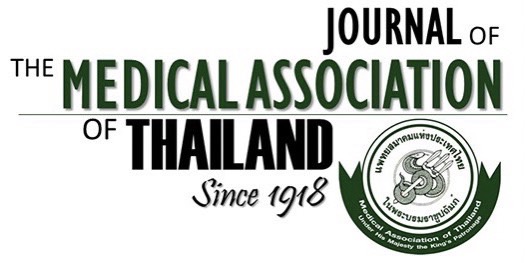Distinguishing Small Primary Lung Cancer from Pulmonary Tuberculoma Using 64-Slices Multidetector CT
Kanyarat Totanarungroj MD*, Sutasinee Chaopotong MD*, Trongtum Tongdee MD*
Affiliation : *Department of Radiology, Faculty of Medicine Siriraj Hospital, Mahidol University, Bangkok, Thailand
Objective : To evaluate which CT findings help in distinguishing small primary lung cancer from tuberculoma.
Material and Method: Forty-two chest CT studies with pathological diagnosis of primary lung cancer (n = 27) and
tuberculoma (n = 15) were retrospectively reviewed by two radiologists who were blind to the pathological results. The CT
findings of number, size, shape, border, and location of the nodules, the presence or absence of satellite nodule, contrast
enhancement, internal air bronchogram, internal calcification, internal cavitation, bronchovascular invasion, and bony
destruction were evaluated.
Results : About 96% of primary lung cancer had a solitary lesion compared to only 60% among tuberculoma (p < 0.05). The
nodule size > 2-3 cm is more likely to be primary lung cancer compared with tuberculoma (p = 0.058). Both primary lung
cancer and tuberculoma can occur in all lobes of both lungs but more frequently in the upper lobe, which has no statistically
significant difference between these two groups. Tuberculoma seems to be round or polygonal shape and primary lung cancer
is more likely to be lobulated shape. The smooth border nodule is found only in tuberculoma (27%) whereas 93% of primary
lung cancer had spiculated border compared to 73% among tuberculoma (p < 0.05). Tuberculoma seems to have more
satellite nodule than primary lung cancer (47% vs. 22%, p = 0.163). The enhancement of nodule and air bronchogram are
significantly found in primary lung cancer compared with tuberculoma (p < 0.05). Tuberculoma seems to have dense central
calcification and primary lung cancer seems to have punctate calcification (p < 0.05). Most of the primary lung cancer and
tuberculoma do not have internal cavity. The presence of bronchovascular invasion was significantly found in primary lung
cancer compared with tuberculoma (p < 0.05). No evidence of bony destruction was observed in both pulmonary tuberculoma
and primary lung cancer groups.
Conclusion : The solitary lesion size < 3 cm in diameter with spiculated border, contrast enhancement, presence of air
bronchogram, punctate calcification and bronchovascular invasion are useful CT findings for diagnosis of primary lung
cancer. However, the lesions with inconclusive findings, tissue diagnosis may be necessary.
Keywords : Air bronchogram, Multidetector CT, Primary lung cancer, Pulmonary tuberculoma, Satellite nodule



